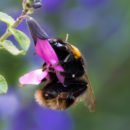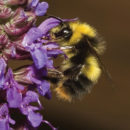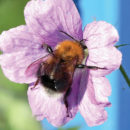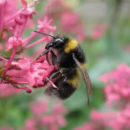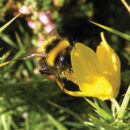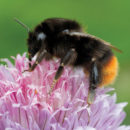[et_pb_section bb_built=”1″ fullwidth=”off” specialty=”on”][et_pb_column type=”3_4″ specialty_columns=”3″][et_pb_row_inner admin_label=”Row”][et_pb_column_inner type=”4_4″ saved_specialty_column_type=”3_4″][et_pb_text _builder_version=”3.17.6″]

[/et_pb_text][et_pb_post_title _builder_version=”3.17.6″ meta=”off” featured_image=”off” /][et_pb_text _builder_version=”3.17.6″]
 Darryl Cox, senior science and policy officer at the Bumblebee Conservation Trust, writes about how bumblebees are affected by modern farming and what we can do to help them.
Darryl Cox, senior science and policy officer at the Bumblebee Conservation Trust, writes about how bumblebees are affected by modern farming and what we can do to help them.
As well as their familiar bumbling flight and distinctive buzz, bumblebees are renowned for having a work ethic which is second to none. Foragers head out of their nest at dawn and are hard at it until dusk, industriously collecting pollen and nectar for their colonies. Built for the British climate, they venture out in the cold and the rain, relentlessly collecting resources, pollinating our crops and flowers as they go. Their importance as pollinators should not be underestimated. Insect pollinators are estimated to contribute more than £600 million per year to the UK economy, and bumblebees play the key role in this group. Without them, many crop yields would suffer and our wild flowers would struggle to reproduce, which would have a negative impact on the whole ecosystem.
Sadly, however, the fate of our 27 bumblebee species has taken a downturn over the past century. Cullum’s bumblebee (Bombus cullumanus) was last seen in Britain on the Berkshire Downs in 1941. One species, the short-haired bumblebee (Bombus subterraneus) was officially declared extinct in the UK in 2000 and now its status on our shores depends on the outcome of a reintroduction programme. A further seven species have declined dramatically, with two of these species in real trouble: the Great Yellow (B distinguendus), once found throughout the UK, now restricted to the Scottish Islands and the very tip of mainland Scotland, and the Shrill Carder (B sylvarum), which is hanging on in pockets across the south of England and Wales.
Farming practices have changed dramatically over the last 80 years. The mechanisation of agriculture, political decisions in response to food shortages during the war, productivity-based subsidies, and pressure from supermarkets and their consumers have combined to create the highly productive, intensified agricultural practices we see today. Productivity of the land has increased enormously in order to feed a vastly increased and more demanding population. But this change has had consequences. The British countryside now has fewer hedgerows, clover-rich horse paddocks, uncultivated odd corners or traditional hay meadows. These have largely become obsolete in modern conventional farming with the advent of inorganic fertiliser. The loss of foraging habitat for bees and other pollinating insects across the UK has been massive; nationwide, over 97 per cent of flower-rich hay meadows have been lost to development or agricultural improvement since 1937. This has had a massive effect on the species which live there. Combined with more modern pressures like expanding development, pesticide use and climate change, the area available, even for the beneficial insects, such as bumblebees, has decreased catastrophically.
(Bombus terrestris)
(Bombus pratorum)
(Bombus hypnorum)
(Bombus hortorum)
(Bombus jonellus)
(Bombus lapidaries)
The Bumblebee Conservation Trust is a charity set up in 2006 to reverse the declines seen in UK bumblebees over the past century. It works with the general public, farmers, government agencies, other NGOs and land managers to increase understanding of the benefits that bumblebees provide, and to pass on knowledge of how best to support pollinator populations. By encouraging people to manage their land sympathetically for bumblebees, the Trust has shown that even very rare species can begin to recover.
The Trust also runs BeeWalk, which keeps track of how bumblebees are doing in the UK, and helps us understand what’s happening over the short to medium term. The scheme involves hundreds of volunteers walking a fixed route in their local area once a month, between March and October (bumblebee season), counting the bumblebees they see along the way.
Bumblebees’ favourite habitats include wildflower-rich meadows and pastures, pollen and nectar-rich field margins, orchards, hedgerows, ditches, brownfield and industrial sites, heathland and coastal strips. Sensitive management of these habitats is essential to help bumblebees survive in the long-term.
Because game shoots are managed for game birds and rarely use heavy machinery, they can bring enormous benefits to insects. With a few slight tweaks, they can provide ideal pollinator habitats. Many shooters already manage field margins for game cover and feed crops, which is already making a huge difference for pollinators.
[box]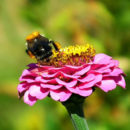 Ensuring that the seeds you buy include plenty of flowering plants, preferably long-flowering or flowering throughout spring, summer and into autumn, will give bumblebees and other insects a reliable food source throughout the season. Such plants include flowering kale, fodder radish, borage, clover and mustard – all of which will also help feed your birds.
Ensuring that the seeds you buy include plenty of flowering plants, preferably long-flowering or flowering throughout spring, summer and into autumn, will give bumblebees and other insects a reliable food source throughout the season. Such plants include flowering kale, fodder radish, borage, clover and mustard – all of which will also help feed your birds.
Hedgerows are also crucial for pollinators, so if you’re thinking about planting a new hedge, or your established hedge needs some filling-in, try to go for flowering varieties if you can. Examples include hawthorn, blackthorn, rowan, crab apple and dog rose.
[/box]
Other thing you could do that would help is to try to keep any digging during winter and early spring (especially around sheltered areas where bumblebees could potentially hibernate) to a minimum. Cutting down on pesticide use will also help keep the bees healthy.
If you have enough time on your hands, or have members with young children on the shoot who would like to do their bit for conservation, you could make bee houses for bumblebees and solitary bees – they’re quick to make and would be a huge advantage for the pollinators looking for nesting sites in spring. You can find instructions on the internet.
To find out more about the work of the Bumblebee Conservation Trust and to access free land-management advice, please visit: bumblebeeconservation.org
[box]
Why not support bumblebees even further?
 You could take part in a BeeWalk, which is a national recording scheme run by the Bumblebee Conservation Trust to monitor the abundance of bumblebees across the country. All you need to do is count the bumblebees you see on a monthly walk along a set route from March to October.
You could take part in a BeeWalk, which is a national recording scheme run by the Bumblebee Conservation Trust to monitor the abundance of bumblebees across the country. All you need to do is count the bumblebees you see on a monthly walk along a set route from March to October.
Click here to find out more about the scheme. [/box]
Images by Ian Blackley, mR’07, Andrea Finch, Rose Lander, Nick Owens and Tessa Bramall
[/et_pb_text][/et_pb_column_inner][/et_pb_row_inner][/et_pb_column][et_pb_column type=”1_4″][et_pb_sidebar _builder_version=”3.17.6″ area=”sidebar-1″ orientation=”right” /][/et_pb_column][/et_pb_section]
